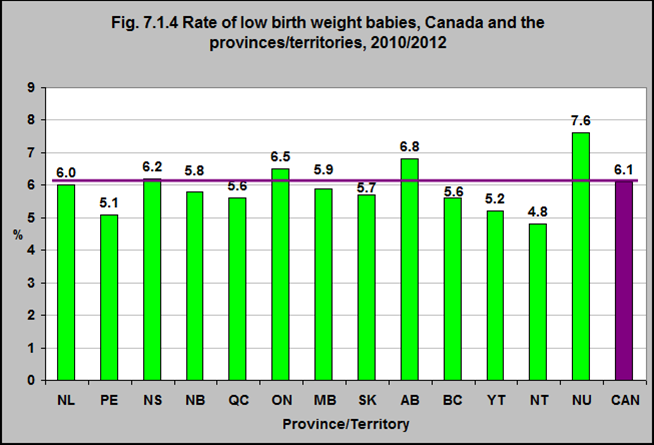Rate of low birth weight babies, Canada and the provinces/territories, 2010/2012

Note: Live births with a birth weight less than 2,500 grams, expressed as a percentage of all live births (birth weight known).
Source: CICH graphic created using data adapted from Statistics Canada. Table 102-4318 – Birth-related indicators (low and high birth weight, small and large for gestational age, pre-term births), by sex, three-year average, Canada, provinces, territories, census metropolitan areas and metropolitan influence zones, occasional (number unless otherwise noted). http://www5.statcan.gc.ca/cansim/a26?lang=eng&retrLang=eng&id=1024318&&pattern=&stByVal=1&p1=1&p2=-1&tabMode=dataTable&csid= – accessed June 20, 2017.
In 2010/12, the low birth weight (less than 2,500 grams) varied between provinces and territories.
It was 7.6% in Nunavut, 5.1% in Prince Edward Island and 4.8% in the Northwest Territories, compared to the national average of 6.1%.
Implications
Low birth weight is considered an important health indicator, because it is linked with many health problems across the life span.1
Babies who are born with low birth weight are born either at term or before term. Because they are not a homogeneous group, risk of their physical and developmental health problems varies. The majority of low birth weight babies have normal outcomes, however, as a group they have higher incidences of below average growth, illnesses and neurodevelopmental problems, such as cognitive, attention and neuromotor functioning. These problems persist into adolescence. Those babies with the lowest birth weight have the highest risks. Low birth weight babies who live with socioeconomic/demographic risk have a higher likelihood of having cognitive problems that persist as the child grows. Programs that provide interventions and enrichment for these children help optimize their development.2 Therefore, it is important that the provinces/territories have such programs to support these infants and children.
1March of Dimes. Low Birthweight. 2014. http://www.marchofdimes.org/complications/low-birthweight.aspx -accessed August 31, 2917
2Hack M, Klein NK and Taylor HG. Long-term developmental outcomes of low birth weight infants. Future Child. 1995 Spring;5(1):176-96. https://www.ncbi.nlm.nih.gov/pubmed/7543353 -accessed August 31, 2017.
